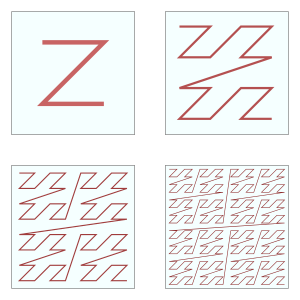
Back Corba de Lebesgue Catalan Mortonův rozklad Czech Z-Kurve German Καμπύλη Z-τάξης Greek خم مرتبه زد Persian Courbe de Lebesgue French Z階数曲線 Japanese Кривая Мортона Russian Kriva oblika Z Serbian

In mathematical analysis and computer science, functions which are Z-order, Lebesgue curve, Morton space-filling curve,[1] Morton order or Morton code map multidimensional data to one dimension while preserving locality of the data points. It is named in France after Henri Lebesgue, who studied it in 1904,[2] and named in the United States after Guy Macdonald Morton, who first applied the order to file sequencing in 1966.[3] The z-value of a point in multidimensions is simply calculated by interleaving the binary representations of its coordinate values. Once the data are sorted into this ordering, any one-dimensional data structure can be used, such as simple one dimensional arrays, binary search trees, B-trees, skip lists or (with low significant bits truncated) hash tables. The resulting ordering can equivalently be described as the order one would get from a depth-first traversal of a quadtree or octree.
- ^ Discrete Global Grid Systems Abstract Specification (PDF), Open Geospatial Consortium, 2017
- ^ Dugundji, James (1989), Wm. C. Brown (ed.), Topology, Dubuque (Iowa), p. 105, ISBN 0-697-06889-7
- ^ Morton, G. M. (1966), A computer Oriented Geodetic Data Base; and a New Technique in File Sequencing (PDF), Technical Report, Ottawa, Canada: IBM Ltd.
© MMXXIII Rich X Search. We shall prevail. All rights reserved. Rich X Search

